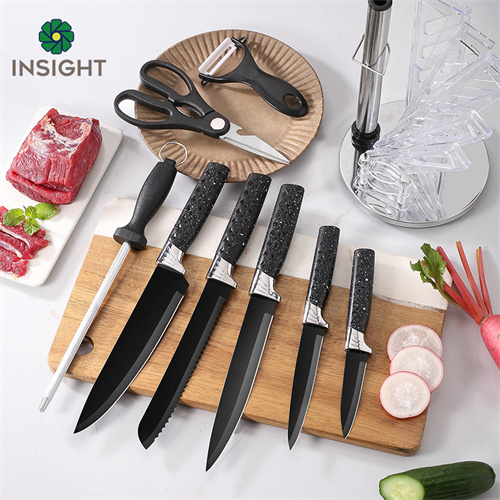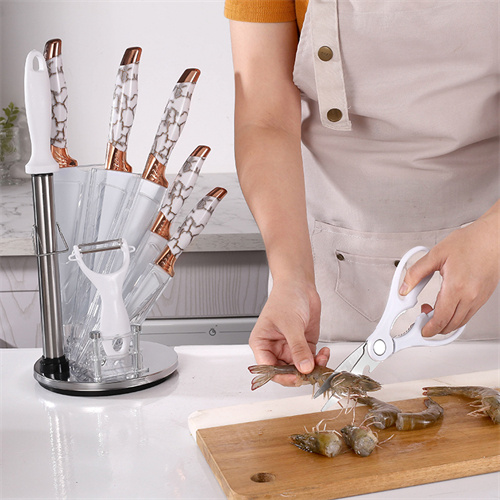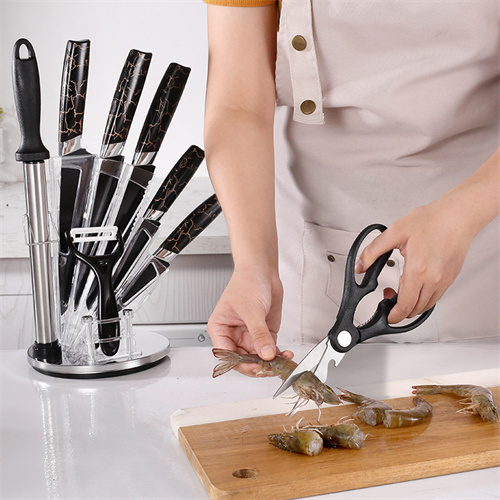

Views: 800 Author: sales@insightknife.com.cn Publish Time: 2025-02-06 Origin: Site








Content Menu
● Understanding Blade Materials
>>> Stainless Steel
>>> Carbon Steel
>>> Ceramic
>>> Titanium
● Factors Affecting Sharpness Retention
>> Sharpness Retention Over Time
● Frequently Asked Questions regarding Kitchen Knife
>> 1. What is the best material for kitchen shears to maintain sharpness?
>> 2. How often should kitchen shears be sharpened?
>> 3. Can ceramic kitchen shears be sharpened?
>> 4. What maintenance is required for carbon steel kitchen shears?
>> 5. How do environmental factors affect the performance of kitchen shears?
The sharpness retention of kitchen shears is a critical factor for both professional chefs and home cooks. The materials used in the blades significantly influence how long the shears maintain their sharpness, which in turn affects their performance and usability. This article delves into the various blade materials, their properties, and how they impact the sharpness retention of kitchen shears over time.
Kitchen shears can be made from a variety of materials, each with its own set of characteristics. The most common materials include stainless steel, carbon steel, ceramic, and titanium. Understanding these materials is essential for selecting the right shears for your kitchen needs, as each material offers unique advantages and disadvantages that can affect your cooking experience.
Stainless steel is one of the most popular materials for kitchen shears. It is known for its corrosion resistance, durability, and ease of maintenance. Stainless steel blades can retain sharpness well, but their performance can vary based on the specific alloy used. Higher-quality stainless steel, such as VG-10 or AUS-8, tends to offer better edge retention compared to lower-grade options. The alloy composition can also influence the blade's hardness and flexibility, making it suitable for various cutting tasks. Additionally, stainless steel is less likely to stain or rust, making it a practical choice for everyday kitchen use.

Carbon steel blades are renowned for their ability to achieve a very sharp edge and maintain it for a longer period. This material is favored by many professional chefs who require precision and performance in their tools. However, they are more susceptible to rust and staining, which requires more care and maintenance. Chefs who prioritize sharpness often prefer carbon steel, but they must be diligent about cleaning and drying the blades after use. The trade-off for the superior sharpness is the need for regular oiling and careful storage to prevent corrosion. Understanding how to care for carbon steel shears can significantly enhance their longevity and performance.
Ceramic blades are known for their exceptional hardness, which allows them to maintain sharpness for an extended period. They are also resistant to rust and staining, making them an attractive option for those who want low-maintenance tools. However, ceramic blades can be brittle and may chip or break if dropped or used on hard surfaces. While they offer excellent sharpness retention, their fragility can be a drawback in a busy kitchen environment. Users should be aware of the limitations of ceramic blades and consider using them for specific tasks that do not involve heavy-duty cutting.
Titanium blades are lightweight and resistant to corrosion, making them a popular choice for kitchen shears. They can maintain sharpness well, but their edge retention is generally not as high as that of high-carbon steel. Titanium blades are often coated with other materials to enhance their performance and durability. The lightweight nature of titanium makes it easier to handle, especially for prolonged use, reducing fatigue during cutting tasks. However, users should be mindful of the coating, as it can wear off over time, potentially affecting the blade's performance.
The hardness of the blade material is a crucial factor in sharpness retention. Harder materials can be sharpened to a finer edge and tend to hold that edge longer. The Rockwell hardness scale is commonly used to measure the hardness of knife blades. A higher Rockwell rating indicates a harder blade, which typically translates to better edge retention. However, it is essential to balance hardness with toughness; a blade that is too hard may become brittle and prone to chipping. Understanding the hardness of different materials can help users select shears that meet their specific cutting needs while ensuring durability.

The way kitchen shears are used can significantly impact their sharpness retention. Techniques such as cutting through tough materials or using the shears on hard surfaces can lead to quicker dulling. Proper cutting techniques, such as using the shears for their intended purpose and avoiding hard surfaces, can help maintain sharpness. Additionally, employing a smooth, controlled cutting motion rather than a sawing action can reduce wear on the blades. Educating users on the best practices for using kitchen shears can prolong their lifespan and enhance performance.
Regular maintenance is essential for preserving the sharpness of kitchen shears. This includes proper cleaning, drying, and occasional sharpening. Different materials require different care methods. For instance, carbon steel blades need to be oiled to prevent rust, while stainless steel blades can be cleaned with soap and water. Users should also consider investing in a quality sharpening tool designed for their specific blade material. Regularly checking the sharpness and performing maintenance can prevent the need for more extensive repairs or replacements, ultimately saving time and money in the long run.
Environmental conditions can also affect sharpness retention. Humidity and exposure to moisture can lead to rusting, particularly in carbon steel blades. Storing kitchen shears in a dry environment and using protective sheaths can help mitigate these issues. Additionally, temperature fluctuations can affect the integrity of the blade material, especially for ceramic and titanium. Users should be mindful of where they store their shears and consider using a dedicated knife block or magnetic strip to keep them safe and dry.
When comparing the sharpness retention of different blade materials, it is essential to consider how each material performs under regular use. Stainless steel blades generally offer a good balance of sharpness retention and ease of maintenance. Carbon steel blades excel in sharpness but require more care. Ceramic blades maintain sharpness exceptionally well but are prone to chipping. Titanium blades provide a lightweight option with decent sharpness retention. Understanding these differences can help users choose the right shears for their cooking style and frequency of use, ensuring they have the best tools for their culinary tasks.
The cost of kitchen shears can vary significantly based on the blade material. While high-quality materials like carbon steel and ceramic may come at a premium, their performance in terms of sharpness retention can justify the investment. Conversely, lower-cost options may not hold their edge as well, leading to more frequent replacements. Users should weigh the initial cost against the long-term benefits of investing in higher-quality shears. Additionally, considering the frequency of use and the types of tasks performed can help determine the best value for money.
The choice of blade material plays a pivotal role in the sharpness retention of kitchen shears. Understanding the properties of stainless steel, carbon steel, ceramic, and titanium can help users make informed decisions based on their cooking habits and maintenance preferences. By considering factors such as cutting techniques, maintenance, and environmental conditions, users can maximize the lifespan and performance of their kitchen shears. Ultimately, investing in high-quality materials and proper care will lead to better sharpness retention and a more enjoyable cooking experience.

The best material for kitchen shears to maintain sharpness is often considered to be high-carbon stainless steel. This material combines the sharpness and edge retention of carbon steel with the corrosion resistance of stainless steel, making it ideal for kitchen use.
Kitchen shears should be sharpened regularly, depending on their usage. For frequent use, sharpening every few months is advisable. If you notice that the shears are struggling to cut through materials easily, it may be time to sharpen them, regardless of the time elapsed since the last sharpening.
Yes, ceramic kitchen shears can be sharpened, but it requires specialized tools designed for ceramic blades. Traditional sharpening methods may not be effective, and users should be cautious to avoid damaging the brittle ceramic material.
Carbon steel kitchen shears require regular maintenance to prevent rust and corrosion. This includes cleaning them after each use, drying them thoroughly, and applying a light coat of oil to the blades to protect against moisture.
Environmental factors such as humidity and temperature can significantly affect the performance of kitchen shears. High humidity can lead to rust, especially in carbon steel blades, while extreme temperature changes can impact the integrity of ceramic and titanium blades. Proper storage in a dry, stable environment can help mitigate these issues.
How do the blade materials affect the sharpness retention of kitchen shears over time?
Are There Any Specific Safety Precautions To Consider When Using Kitchen Shears?
Are There Any Specific Safety Precautions To Consider When Using Different Types of Kitchen Shears?
Are There Any Specific Regulations Regarding Kitchen Shear Safety in Professional Kitchens?
What Are Some Safety Tips for Using Kitchen Shears in The Kitchen?
How Do Different Blade Types in Kitchen Shears Affect Cutting Performance?
What Are The Key Differences between Kitchen Shears And Regular Scissors?